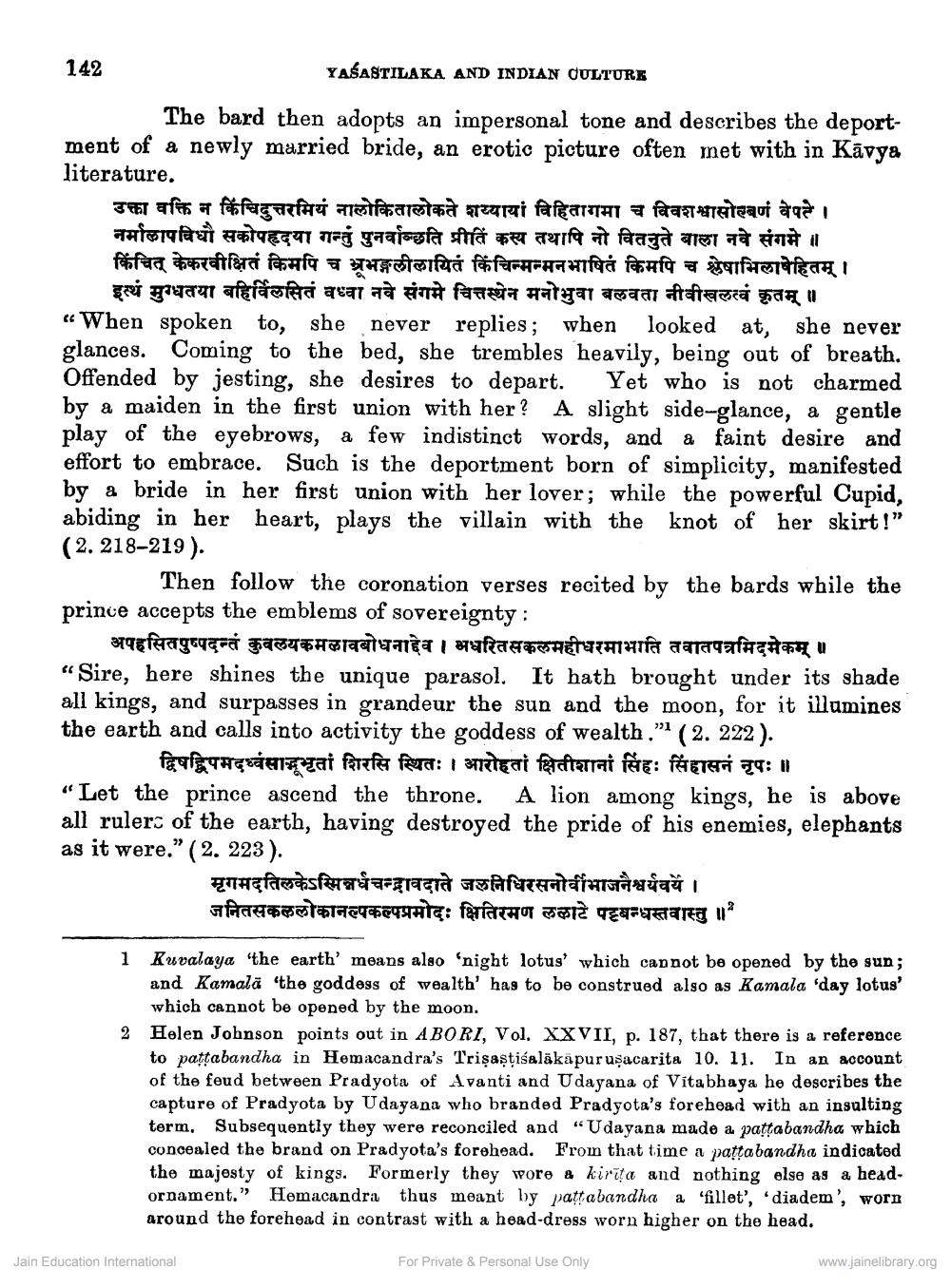________________
142
YAŠASTILAKA AND INDIAN CULTURE
The bard then adopts an impersonal tone and describes the deportment of a newly married bride, an erotic picture often met with in Kavya literature.
उक्ता वक्ति न किंचिदुत्तरमियं नालोकितालोकते शय्यायां विहितागमा च विवशश्वासोल्बणं वेपते । नर्मालापविधी सकोपहृदया गन्तुं पुनर्वाग्छति प्रीति कस्य तथापि नो वितनुते बाला नवे संगमे । किंचित् केकरवीक्षितं किमपि च भ्रभङ्गलीलायितं किंचिन्मन्मनभाषितं किमपि च श्लेषाभिलाषेहितम् ।
इत्थं मुग्धतया बहिर्विलसितं वध्वा नवे संगमे चित्तस्थेन मनोभुवा बलवता नीवीखलत्वं कृतम् ॥ “When spoken to, she never replies; when looked at, she never glances. Coming to the bed, she trembles heavily, being out of breath. Offended by jesting, she desires to depart. Yet who is not charmed by a maiden in the first union with her? A slight side-glance, a gentle play of the eyebrows, a few indistinct words, and a faint desire and effort to embrace. Such is the deportment born of simplicity, manifested by a bride in her first union with her lover; while the powerful Cupid, abiding in her heart, plays the villain with the knot of her skirt !” (2. 218-219).
Then follow the coronation verses recited by the bards while the prince accepts the emblems of sovereignty: ____अपहसितपुष्पदन्तं कुवलयकमलावबोधनादेव । अधरितसकलमहीधरमाभाति तवातपत्रमिदमेकम् ॥ “Sire, here shines the unique parasol. It hath brought under its shade all kings, and surpasses in grandeur the sun and the moon, for it illumines the earth and calls into activity the goddess of wealth." (2. 222).
द्विषद्विपमदध्वंसाद्भूभृतां शिरसि स्थितः । आरोहतां क्षितीशानां सिंहः सिंहासनं नृपः॥ "Let the prince ascend the throne. A lion among kings, he is above all rulers of the earth, having destroyed the pride of his enemies, elephants as it were." (2. 223).
मृगमदतिलकेऽस्मिन्नर्धचन्द्रावदाते जलनिधिरसनोर्वीभाजनैश्वर्यवयें । जनितसकललोकानल्पकल्पप्रमोदः क्षितिरमण ललाटे पट्टबन्धस्तवास्तु ॥"
1 Kuvalaya 'the earth' means also 'night lotus' which cannot be opened by the sun;
and Kamalā 'the goddess of wealth' has to be construed also as Kamala 'day lotus'
which cannot be opened by the moon. 2 Helen Johnson points out in ABORI, Vol. XXVII, p. 187, that there is a reference
to pattabandha in Hemacandra's Trişaştisalākapuruşacarita 10. 11. In an account of the feud between Pradyota of Avanti and Udayana of Vitabhaya he describes the capture of Pradyota by Udayana who branded Pradyota's forehead with an insulting term. Subsequently they were reconciled and “Udayana made a pattabandha which concealed the brand on Pradyota's forehead. From that time a pattabandha indicated the majesty of kings. Formerly they wore & kirita and nothing else as a headornament.” Hemacandra thus meant by pattabandha a 'fillet', diadem', worn around the forehead in contrast with a head-dress worn higher on the head.
Jain Education International
For Private & Personal Use Only
www.jainelibrary.org




